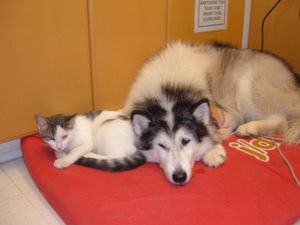
New Baby, Old Dog
Considerations for introducing your baby with your dog.
So, your family is having a baby! Congratulations! Among the many things to consider with the new baby, is how is your dog going to accept it? A major consideration is to start long before the baby’s arrival. Preparation now could save many headaches, and heartaches later.
First, consider your dog’s personality. If your pet has shown any aggression to children in the past, recognize that you will never be able to completely trust your pet-but you can do a lot to lessen any problems. Is your pet possessive of toys, or does your pet suffer from any condition that may cause pain if touched in the hind-end or ears? For example, if your pet is sensitive to sudden movements, the baby could trigger unwanted behaviour. Always keep in mind that not all pets will be aggressive, some will just need to keep space between themselves and the baby. Adjusting your furniture to allow easy escape from a baby may be one idea.
While the pregnancy progresses, a refresher obedience course is a wise first option, even if you anticipate few problems with your pet. Among the basic behaviours to reinforce are two additional ones. I like to teach the pet the meaning of the word ‘careful’ said slowly-it sounds a bit like a growl and, you don’t fall into the trap of saying ‘No’ repeatedly. In fact anything the dog sees as punishment, if used after the baby’s arrival, could be misread by your pet-causing increased anxiety anytime the baby is around your pet. The second technique to build into your pet’s behaviour is to say ‘…What was that?’ Try saying this calmly while gently pinching the skin or, tugging lovingly on an ear or tail for example. Anytime you begin to use either technique, reward your pet for acceptable behaviour with verbal praise and an occasional treat.
Another useful technique is to start changing your pet’s routine before the babies’ arrival-not getting up on the couch, or any change in your walks. If you anticipate the need for a head halter-now is the time to have your pet get used to it. In fact, if you anticipate that your pet will be nervous, a halter gives increased control during introductory periods.
During the first meetings, please stay calm. Having the dog comfortable in the room first and bringing the baby to your pet is best. One key to reducing anxiety now is to have lots of treats handy, and while encouraging your pet to interact with your baby, add in the occasional command, such as sit, or down, and give lots of praise. Soon your pet will expect to behave normally with the baby, and know that treats are a part of it!
Once your baby has arrived, a productive method to lessen your pet’s anxiety is to pay them more attention when the baby is awake and, less when the baby is asleep or out with your partner. Ensure that you allow your pet to be a part of the family in every way, using a chew bone while the baby is crying for example will help with any fearful response, or feeding both the baby and your pet at the same time can really build up a positive relationship.
Finally, the use of an Adaptyl pheromone plug in diffuser is a great asset for you to use – the feline version is ‘Feliway’. These diffusers release calming pheromones into the air of your home, covering 800 sq ft. and, you cannot smell them nor do they have an ill effect on you nor your child. Instead, these are calming pheromones – in fact they are the same as those released by nursing mother dogs & cats, and calm your pet’s anxiety more then you can believe!
Please do not forget to never leave your dog alone with your baby – even the best dog can find itself in a situation with your newborn that it cannot manage, and accidents occur. The most common form of accident with a baby is as it begins to explore its world – getting into the dog food can led to an instant response from your dog. So putting the food up out of their reach between meals is one manner to prevent this accident, and restricting your baby from getting near your dog while it eats is another way to avoid a problem before one can occur!
Please contact your Veterinarian for more information – submitted by Dr. Jeff Goodall, Sunnyview Animal Care, 1746 Bedford Highway, Bedford, Nova Scotia. Your Bedford Veterinarian, your Halifax Veterinarian, and your Lower Sackville Veterinarian! #sac
We also love to help you care for your exotic pets too – Sunnyview is your Exotic Pet Vet! We are Located on the Bedford Highway Vet!


